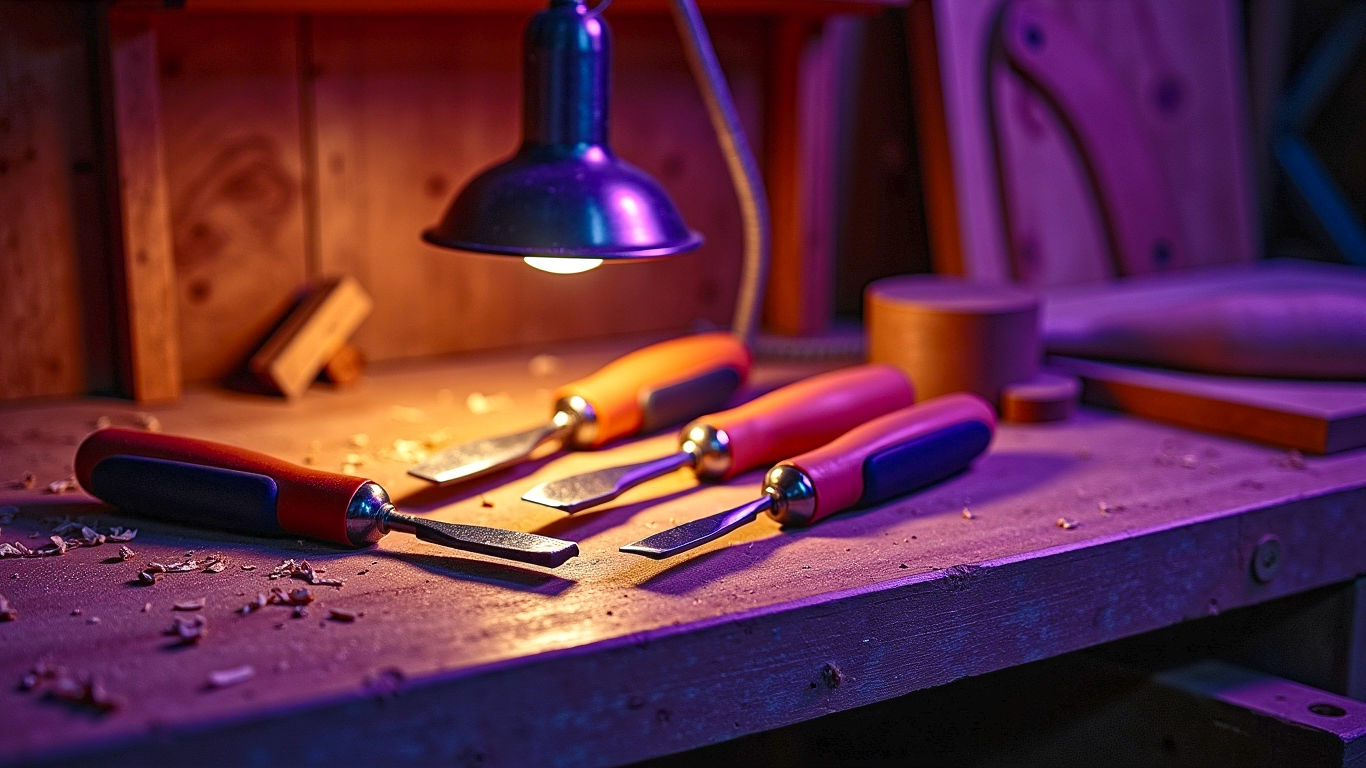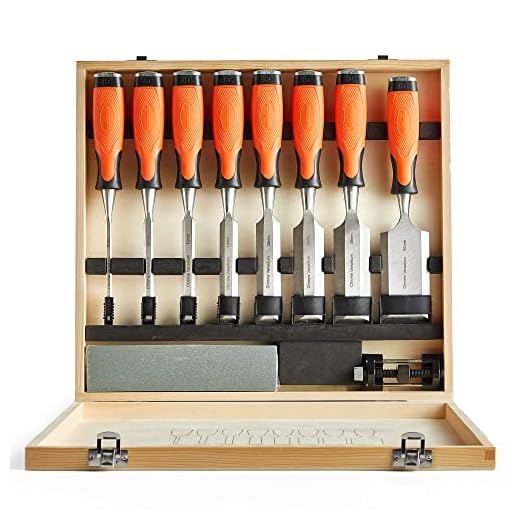Your New Best Friend in the Shed? Guide to the VonHaus 10-Piece Wood Chisel Set
Discover why the VonHaus 10-Piece Chisel Set is the perfect toolkit for British DIY fans. A comprehensive guide to getting started with woodworking.

This post may contain affiliate links. If you make a purchase through these links, we may earn a commission at no additional cost to you.
Ever stood in your shed, garage, or that little corner of the spare room, looked at a piece of wood, and thought, “I could make something brilliant out of that”? Maybe it’s a wonky shelf that needs sorting, a garden planter you’ve been dreaming of, or even just a simple wooden toy for the kids. That feeling, that little spark of creativity, is a feeling that’s been part of British life for centuries. From the magnificent timber roofs of our cathedrals to the humble garden gate, working with wood is in our blood.
But to turn that spark into something real, you need the right tools. Not a shed full of expensive, complicated gear, but a solid, reliable set of tools that feel right in your hand and do the job properly. That’s where the VonHaus 10-Piece Premium Wood Carving Chisel Set comes in.
VonHaus Chisel Set – 10pcs Woodworking Tools Set – Wood Carving Tools, Wood Chisel Sets with Sharpening Stone, Honing…
-
Constructed from high-quality, durable chrome vanadium steel for long-lasting performance.
-
Comprehensive 10-piece woodworking set includes a wide range of split-proof chisels from 6mm to 50mm.
-
Each chisel features narrow side bevels, a rubber ergonomic grip handle for comfort, and a metal strike cap for use with a hammer.
-
The set comes complete with a honing guide and an aluminum oxide sharpening stone to maintain the blades.
-
Includes a wooden case with inner labeling and holders for easy organization and storage.
-
Suitable for a variety of timber and woodworking projects.
Think of this set as your perfect starting point, or a brilliant upgrade from that old, rusty chisel you inherited from your grandad. It’s designed for people like you and me – folks who appreciate quality but don’t want to spend a fortune. It’s for the weekend DIY-er, the budding craftsperson, and anyone who fancies giving woodworking a proper go.
In this guide, we’re going to get properly stuck into this chisel set. We’ll look at what’s in the box, why it’s a cut above the rest, and how you can use it to start your own woodworking adventures. We’ll cover everything from the tough steel they’re made from to how to keep them sharp enough to slice through wood like a hot knife through butter. So, grab a cuppa, get comfortable, and let’s talk about turning timber into treasure.
What’s in the Box? A Look at Your New Toolkit
Opening the VonHaus set feels a bit like Christmas morning for a DIY enthusiast. It doesn’t arrive in a flimsy plastic packet; it comes in a proper wooden presentation case. This isn’t just for show. It keeps your tools organised, safe, and ready for action. No more hunting around in a cluttered drawer for the right size. Everything has its place, clearly labelled, so you can grab what you need in a flash.
Inside, you’ll find a carefully curated collection designed to handle almost any woodworking job you can throw at it.
1) The Eight Essential Chisels
The heart of the set is, of course, the chisels themselves. You get eight of them, which is a fantastic range for a single set. They are:
- 6mm (about 1/4 inch): Perfect for getting into tight corners and carving fine details. Think of it for cleaning out the edges of a mortise joint or carving delicate patterns.
- 10mm (about 3/8 inch): A great all-rounder for smaller, precise jobs.
- 13mm (about 1/2 inch): A classic size, ideal for creating medium-sized joints and shaping edges.
- 19mm (about 3/4 inch): Your go-to chisel for a huge range of tasks, from general-purpose shaping to cutting rebates.
- 25mm (1 inch): When you need to remove a bit more wood, this one steps up. It’s brilliant for larger joints and bigger shaping jobs.
- 32mm (about 1 1/4 inches): Now we’re getting into the bigger lads. This is for serious wood removal, like roughing out a shape or clearing out large areas.
- 38mm (about 1 1/2 inches): A powerful chisel for when you need to flatten a surface or make big, bold cuts.
- 50mm (2 inches): The beast of the set! This is what you’ll use for heavy-duty work, like timber framing or quickly removing large amounts of waste wood.
This range is what makes the set so versatile. You’re not just getting a couple of chisels; you’re getting a whole family of them, ready for any project, big or small.
2) The Sharpening Kit: Your Secret to a Perfect Edge
A blunt chisel is worse than useless – it’s dangerous. It can slip, tear the wood, and cause accidents. VonHaus knows this, which is why they’ve included a complete sharpening kit right in the box. This is a game-changer, especially for beginners.
- Honing Guide: This little gadget is pure genius. One of the trickiest parts of sharpening is keeping the chisel at the perfect angle. The honing guide clamps onto the chisel blade and has a little wheel that runs along your sharpening stone. It takes all the guesswork out of the process, ensuring you get a razor-sharp, perfectly angled edge every single time. It’s like having a professional sharpening expert guiding your hand.
- Aluminium Oxide Sharpening Stone: This isn’t just any old stone. It’s a double-sided block. One side has a coarse grit for quickly grinding a new edge on a damaged or very blunt chisel. The other side has a finer grit for honing that edge to perfection. It’s everything you need to keep your tools in tip-top condition.
Including this kit shows that VonHaus understands what woodworkers really need. They’re not just selling you tools; they’re giving you the means to look after them for years to come.
Built to Last: A Deep Dive into Quality and Design
So, what makes these chisels special? It’s not just about the sizes or the sharpening stone. It’s about the thought and quality that has gone into every part of their design. Let’s break it down.
The Blades: The Business End of the Chisel
The blade is where the magic happens, and the quality of the steel is everything. The VonHaus chisels are made from high-quality chrome vanadium steel. Now, that might sound like a bit of jargon, but it’s really important.
- Simplified Explanation: Think of chrome vanadium steel as a recipe that makes metal extra tough and strong. The chrome helps stop it from rusting, and the vanadium makes it harder and helps it hold a sharp edge for longer. It’s the kind of steel you find in high-quality spanners and socket sets – tools that need to withstand a lot of force without breaking or bending.
- Detailed Explanation: Chrome vanadium steel is a specific alloy (a mix of metals) where a small amount of chromium and vanadium are added to carbon steel. The chromium enhances its hardness and corrosion resistance, while vanadium refines the grain structure of the steel. This fine-grain structure is key – it makes the steel tougher and more resistant to wear and fatigue. The blades are also heat-treated, a process where they are heated to a very high temperature and then cooled in a controlled way. This further hardens the steel, ensuring the cutting edge won’t crumble or deform under pressure.
The blades also have narrow side bevels. This means the sides of the blade are angled, making them thinner. This clever design lets you get right into tight corners, like when you’re cutting a dovetail joint, without the sides of the chisel getting in the way.
The Handles: Comfort and Control in Your Hand
A great blade is useless if you can’t control it. The handles on these chisels are brilliant. They are described as ergonomic, which is just a fancy way of saying they are shaped to fit comfortably in your hand.
They’re made of a tough core with a rubberised grip. This soft-touch finish means you can use them for hours without getting blisters, and it gives you fantastic grip and control, which is vital for safety and precision.
The Strike Caps: Built for a Bashing
At the end of each handle is a metal strike cap. This is another sign of a well-made chisel. It’s designed to be hit with a mallet or hammer. Cheaper chisels with all-plastic or wooden handles can splinter or shatter if you hit them too hard. The metal cap spreads the force of the blow evenly through the handle and down to the blade, so you can make powerful cuts without worrying about damaging your tools.
This feature makes the chisels ‘split-proof’ and suitable for proper carpentry, not just delicate carving. It tells you they are serious tools for serious work.
A Proud British Tradition: The Story of Woodworking and Steel
When you pick up one of these chisels, you’re holding more than just a tool. You’re holding a piece of history. Britain has a long and storied relationship with both woodworking and steelmaking.
From Oak Beams to Intricate Carvings
Wood has been the backbone of Britain for thousands of years. It built our ships, our homes, and our furniture. Think of the incredible hammer-beam roof in Westminster Hall, crafted by Hugh Herland in the 1390s, a masterpiece of English carpentry. Or the intricate wood carvings of Grinling Gibbons, whose work adorns St. Paul’s Cathedral and Hampton Court Palace. His breathtakingly realistic flowers and birds, carved from limewood, show the pinnacle of the craft.
This tradition continued in the workshops of furniture makers like Thomas Chippendale in the 18th century, whose mahogany designs became famous across the world. And it lives on today, not just in grand palaces, in the sheds and workshops of ordinary people across the country. Woodworking is a skill passed down through generations, a practical and creative outlet that connects us to our past.
The Steel City’s Legacy
Just as Britain is famous for its woodwork, it’s also famous for its steel. The story of modern steel is forged in places like Sheffield, the ‘Steel City’. In the 1740s, a clockmaker named Benjamin Huntsman invented a new way to make high-quality steel, perfect for making razor-sharp tools. This innovation made Sheffield the world leader in cutlery and tool production.
The chrome vanadium steel in the VonHaus chisels is a modern descendant of this legacy. It’s a testament to centuries of metallurgical innovation, designed to give us tools that are stronger, sharper, and more durable than ever before. So, when you’re using these tools, you’re part of a long line of British craftsmanship that values quality and durability above all else.
Getting Started: Your First Steps in Woodworking
Right, you’ve got your shiny new chisels. What now? The best way to learn is by doing. Don’t be afraid to just grab a piece of scrap wood and have a go. Here are a few tips and a simple first project to get you started.
Safety First, Always
Before we make a single cut, let’s talk safety. Chisels are incredibly sharp. Treat them with respect.
- Clamp Your Work: Never hold the piece of wood you’re working on with your hand. Always clamp it securely to a workbench. If it moves, the chisel can slip.
- Keep Both Hands Behind the Blade: This is the golden rule. Always position your hands behind the cutting edge. That way, if the chisel slips forward unexpectedly, it won’t cut you.
- Wear Safety Goggles: Wood chips can fly up, especially when you’re using a mallet. Protect your eyes.
- Keep Them Sharp: A sharp chisel is a safe chisel because it cuts predictably and requires less force. Use the included sharpening kit regularly.
How to Sharpen Your Chisels (The Easy Way)
Your new chisels will be sharp out of the box, but it’s a great idea to get them even sharper and to learn how to maintain them.
- Set Up Your Stone: Place your sharpening stone on a non-slip mat. You can use it dry, or with a little water or light oil (check the stone’s instructions) to help float away the metal particles.
- Use the Honing Guide: Clamp the chisel blade into the honing guide. You want the bevel of the chisel (the angled cutting edge) to be flat on the stone. Adjust how far the blade sticks out to get the right angle – around 25-30 degrees is standard for general work.
- Start Sharpening: Start with the coarse side of the stone if the chisel is nicked or very dull. Otherwise, go straight to the fine side. Push the chisel and guide back and forth along the length of the stone. Use smooth, even strokes. You’ll see a little bit of dark metal paste (called slurry) forming – that’s a good sign it’s working.
- Check for the ‘Burr’: After a dozen or so strokes, carefully feel the flat back of the chisel, right at the cutting edge. You should feel a tiny, rough ridge of metal. This is called the ‘burr’. Once you have a burr along the entire edge, you’re ready to flip the chisel over.
- Remove the Burr: Take the chisel out of the guide. Lay it completely flat on its back on the fine side of the stone and give it one or two gentle pulls towards you. This will snap off the burr.
- Test the Sharpness: Be careful! A truly sharp chisel should be able to shave a thin sliver from the edge of a piece of wood with very little effort.
It might sound complicated, but with the honing guide, it’s surprisingly easy. A few minutes of sharpening will make your work a joy.
Your First Project: A Simple Marking Gauge
A marking gauge is a classic woodworker’s tool used to scratch a line parallel to the edge of a piece of wood. Making one is a great way to practise your chiselling skills. You’ll just need a small block of wood (maybe 3x3x1 inches) and a stick or dowel (about 6 inches long).
- Make the Hole: First, you’ll need to make a square hole through the centre of the block for the stick to slide through. Drill a round hole first, then use your smaller chisels (the 6mm or 10mm would be perfect) to carefully square it up. This is called chopping a mortise. Clamp the block firmly and make small, careful cuts. Always chisel away from yourself.
- Shape the Block: Use the larger chisels (like the 19mm or 25mm) to add some decorative chamfers (angled edges) to your block. This is great practice for controlling the chisel with just hand pressure.
- Fashion a Wedge: Cut a small, wedge-shaped piece of wood. This will be used to lock the sliding stick in place. You’ll need to cut a corresponding slot in the block for the wedge to fit into, again using your smaller chisels.
- Add the ‘Scribe’: Finally, you need something to do the marking. Traditionally, this would be a sharpened metal point, but to keep things simple, you can just sharpen the end of the sliding stick to a point using a chisel or a knife.
And there you have it! Your very own, handmade tool. It’s a simple project, but it teaches you precise chiselling, shaping, and how to fit pieces together – the fundamental skills of woodworking.
Common Problems and How to Solve Them
As with any new skill, you might run into a few snags. Don’t worry, it’s all part of the learning process.
- Problem: The wood is tearing or splintering, not cutting cleanly.
- Solution: Your chisel is almost certainly blunt. Stop what you’re doing and sharpen it. You’ll be amazed at the difference. It could also be that you’re trying to remove too much wood in one go. Try making several smaller, thinner cuts instead of one big one.
- Problem: My cuts aren’t straight or accurate.
- Solution: Make sure your wood is clamped down tightly. Use a pencil and a square to mark your lines clearly before you start cutting. When you cut, follow the line, don’t try to force the chisel. Let the sharp edge do the work. Practice on scrap wood to get a feel for how the chisel moves.
- Problem: The chisel gets stuck in the wood.
- Solution: This often happens when cutting deep holes (mortises). Don’t try to ram the chisel all the way in. Make a shallow cut, then gently wiggle the chisel to lever out the chip. Repeat the process, going a little deeper each time.
The Future is Handmade: Why Craft is Making a Comeback
In a world of flat-pack furniture and disposable everything, there’s a growing movement of people rediscovering the joy of making things themselves. The rise of TV shows like The Repair Shop and the popularity of craft markets show that we’re yearning for things that are real, authentic, and have a story.
Working with wood is the perfect antidote to our busy, digital lives. It’s mindful. It forces you to slow down, to focus on the task at hand, and to connect with a natural material. The feeling of turning a rough piece of timber into something smooth, beautiful, and useful is incredibly satisfying. It’s good for the soul.
The VonHaus 10-Piece Chisel Set is more than just a box of tools. It’s a gateway to this world of creativity. It gives you everything you need to start a new hobby, to fix things around the house with pride, and to create unique, handmade items that will last a lifetime. Whether you’re in a bustling city flat in London or a quiet village in the Highlands, this set allows you to tap into that timeless tradition of British craftsmanship.
So, next time you see a piece of wood, don’t just see a bit of timber. See the potential. See the bookshelf, the bird box, or the beautiful carved bowl it could become. And with this set in your hand, you’ll have the power to make it happen.
Further Reading & Resources
- The Wood Tamer (YouTube): A brilliant British woodworker with fantastic, accessible tutorials for beginners.
- Paul Sellers’ Blog: A master woodworker who champions hand-tool skills. His website is a goldmine of information.
- Gen Woodworking: A UK-based forum and community for woodworkers of all skill levels to share tips and projects.







